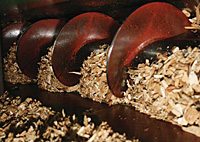Reasons for changing to woodfuel
Pentland Plants was the first horticultural business in the UK
to switch to woodfuel and, at the time, it was the biggest
privately funded biomass project in Scotland.
Aided by the Carbon Trust, a business energy audit and
evaluation of the site requirements was undertaken and a range of
renewable technologies considered. Biomass was judged to be the
easiest and most cost effective method of meeting the business
energy needs. The decision to change to woodfuel was taken in an
attempt to reduce the annual heating costs of £300,000.
The audit identified the need for a robust and simple system.
The company directors undertook several site visits to Austria,
Denmark and Germany to research and investigate European
technologies that would be most suitable for their needs. They also
sought advice from professional organisations, which combined with
their personal research, has ensured a reliable installation.
System features and benefits

A wood fuel boiler was connected to the existing heating system
in the company's glass houses to supersede the existing oil boilers
as the primary source of heating.
Although the oil boilers are not required for daily heating,
space allowed their retention and they were in good serviceable
condition, so it was sensible for them to be retained to provide
extra capacity and security for the future.
The fuel storage shed contains a robust walking floor
system that efficiently moves the large quantities of wood
chip to the boiler.
Wood fuel supply
Pentland Plants sources and produces its woodfuel through its
own wood fuel business, Pentland Biomass. Roundwood is purchased
directly from local forests and stacked to dry for a year to bring
down the moisture content before it is chipped into fuel.
The annual woodfuel consumption warranted the company's own
investment in woodfuel processing equipment, which has been funded
through the significant fuel cost savings and the Scottish Biomass
Heat Scheme.
This self-supply fuel model further reduces the costs of their
heating as well as creating a potential new income stream from
sales of woodfuel to third parties.
Installation issues
Very little modification was required to the existing heat
distribution system due to spare pipe work previously installed in
advance of business expansion. This made the retention of the
original oil boilers simple.
Lessons learned
- Underground fuel storage would allow more space for storing
roundwood on-site
- Dealing with the same boiler manufacturer representative
throughout the installation process can smooth the process
- A large area is required to produce and store a large volume of
wood chip for self-supply
- Large enough chip storage to run your system for a suitable
time, in case of breaks in production, ensures continuous operation
of your boiler
- Plan for and allow the appropriate time to gain planning
approval for your development, if required.
- Planning issues should to be addressed at the earliest
opportunity to reduce delays
- Planning permission for the fuel storage shed and boiler house
proceeded without delay, however the flue height requirement for
the boiler slowed the process
Facts and figures
Note: figures are approximate
| Building |
| Heated area |
21,000 m2 |
| Heated volume |
75,000 m3 |
| Fabric |
Glass and aluminium |
| Heating system |
| Boiler manufacturer |
Reka |
| Maximum boiler output |
2,000 kW |
| Fuel type |
Wood chips |
| Fuel specification |
- Moisture content: <40% (M40)
- Particle size: 80% of chips are <45 mm (P45)
|
| Store capacity |
180 tonnes (800 m3) |
| Back-up/top-up system |
Existing oil boilers (2 MW) retained |
| Fuel consumption, costs and savings |
| Weekly woodfuel use |
270 tonnes (900 m3) at peak 45 tonnes (150 m3) during
summer |
| Annual woodfuel use |
2,500 tonnes |
| Annual energy consumption |
8,000,000 kWh |
| Annual CO2 savings |
2,500 tonnes |
| Wood fuel cost |
£125,000 |
| Annual fuel cost saving at 2008/09 prices |
£256,000 |
| Payback period |
1 year (due to high oil prices during 2008) |
| Installation cost and funding |
| Boiler system |
£260,000 |
| Funding source |
Private finance |
| Funding support rate |
n/a |